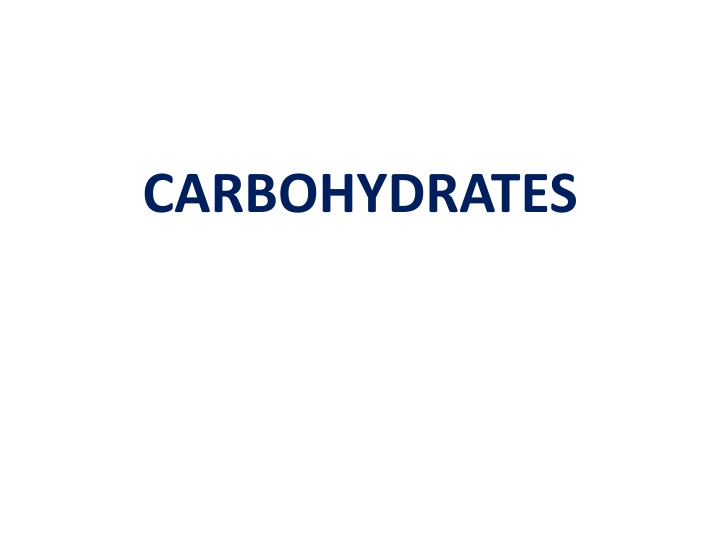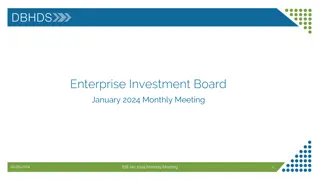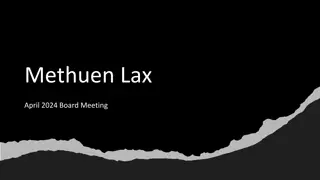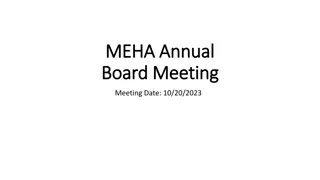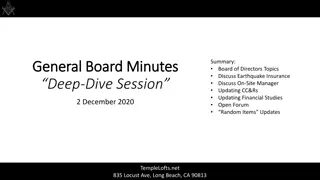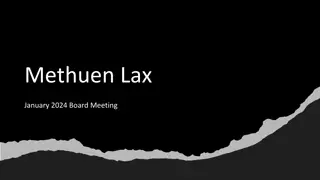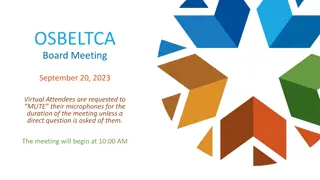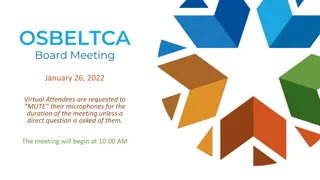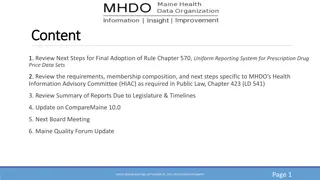MHDO Board Meeting Summary
MHDO Board meeting held on September 5, 2024, covered topics such as final adoption of rule Chapter 340, board composition proposal, review timelines, and update on Maine Quality Forum. The meeting included discussions on the MHDO priorities and guiding principles set by the board in 2013.
Download Presentation

Please find below an Image/Link to download the presentation.
The content on the website is provided AS IS for your information and personal use only. It may not be sold, licensed, or shared on other websites without obtaining consent from the author.If you encounter any issues during the download, it is possible that the publisher has removed the file from their server.
You are allowed to download the files provided on this website for personal or commercial use, subject to the condition that they are used lawfully. All files are the property of their respective owners.
The content on the website is provided AS IS for your information and personal use only. It may not be sold, licensed, or shared on other websites without obtaining consent from the author.
E N D
Presentation Transcript
Introduction Carbohydrates are the most abundant macromolecules in nature. They are the main source and storage of energy in the body. They serve also as structural component of cell membrane. The general molecular formula of carbohydrate is CnH2nOn or (CH2O)n, where n > 3. Chemically, they contain the elements Carbon, hydrogen and oxygen. Thus they are Carbon compounds that contain large quantities of Hydroxyl groups. Carbohydrates in general are polyhydroxy aldehydes or ketones or compounds which give these substances on hydrolysis.
Chemistry of Carbohydrates Classification and Structure Classification There are three major classes of carbohydrates Monosaccharides (mono = one) Oligosaccharides (oligo= few) 2-10 monosaccharide units. Polysaccharides (Poly = many) >10 monosaccharide units.
Monosaccharides Monosaccharides also called simple sugars. They consist of a single polyhydroxy aldehyde or ketone units. The most abundant monosaccharides in nature are the 6-carbon sugars like D-glucose and fructose
Structure Monosaccharide has a backbone, which is un- branched, single bonded carbon chain. One of the carbon atoms is double bonded to an oxygen atom to form carbonyl group. Each of the other carbon atoms has a hydroxyl group. Example. Structure of Glucose Open chain D-glucose -D glucose -D glucose (Fisher formula) (Haworth formula) . structures of D.Glucose
There are two families of monosaccharides. Monosaccharides having aldehyde groups are called Aldoses and monosaccharides with Ketone group are Ketoses. Depending on the number of carbon atoms, the monosaccharides are named trioses (C3), tetroses (C4), pentoses (C5), hexoses (C6), heptoses (C7).
No of carbon Generic name Aldose family Ketose family atoms __________________________________________________ 3 Triose Aldotriose Eg.Glyceraldehyde. Eg. Dihydroxyacetone 4 Tetrose Aldotetrose Eg. Erythrose Ketotriose Ketotetrose Eg. Eyrthrulose 5 Pentose Aldopentose Ketopentose Eg. Ribose Eg. Ribulose,Xylulose 6 Hexose Aldohexose Eg. Glucose Galactose Mannose Ketohexose Eg. Fructose Common Biologically important monosaccharides with their families.
Physical properties Physical properties of Monosaccharides They are colorless, crystalline compounds, readily soluble in water. Their solutions are optically active and exhibit the phenomenon of mutarotation. Carbohydrates spontaneously change between the and configuration.
Asymmetric Center and Stereoisomerism Asymmetric carbon is a carbon that has four different groups or atoms attached to it and having optically activity in solution. All the monosaccharides except dihydroxyacetone contain one or more asymmetric or chiral carbon atoms and thus occur in optically active isomeric forms. Monosaccharides with n number of asymmetric centers will have (2n) isomeric forms. (n= number of asymmetric carbon atoms).
(+)-glucose? An aldohexose Four chiral centers, 24= 16 stereoisomers * * * * CH2CHCHCHCHCH O OH OHOHOHOH CHO OH? CH2OH
The two isomeric forms of glyceraldehyde. The designation of a sugar isomer as the D- form or of its mirror images the L- form is determined by the spatial relationship to the parent compound of the carbohydrate family. The D and L forms of Glyceraldehyde are shown in the Figure 2.2. The orientation of- OH and- H groups around the carbon atom adjacent to the terminal primary alcohol carbon determines its D or L form . When the - OH group on this carbon is on the right, the sugar is a member of the D-series, when it is on the left, it is a member of the L-series. These D and L configuration are also called Enantiomers.
Optical Activity The presence of asymmetric carbon atom causes optical activity. When a beam of plane polarized light is passed through a solution of carbohydrate it will rotate the light either to right or to left. Depending on the rotation, dextrorotatory (+) (d) or levorotatory (-)(l). Thus, D- glucose is dextrorotatory but D- fructose is levorotatory. When equal amounts of D and L isomers are present, the resulting mixture has no optical activity, since the activities of each isomer cancel one another. Such a mixture is called racemic or DL mixture. molecules are called
Epimers When sugars are different from one another, only in configuration with regard to a single carbon atom (around one carbon atom) they are called epimers of each other. For example glucose and mannose are epimers . They differ only in configuration around C2. Mannose and Galactose are epimers of Glucose CHO CHO H OH H OH OH HO HO H H H H OH OH HO H H CH2OH CH2OH D-glucose D-mannose epimers
Anomers The two stereoisomers at the hemiacetal (anomeric) carbon are: o The alpha anomer: Where- OH group is down (Haworth) o The beta anomer: Where- OH group is up (Haworth) Anomers (having different physical properties)
Cyclization of monosaccharides: Monosaccharides with five or more carbon atoms in the backbone usually occur in solution as cyclic or ring structure, in which the carbonyl group is not free as written on the open chain structure but has formed a covalent bond with one of the hydroxyl group along the chain to form a hemiacetal or hemiketal ring. In general, an aldehyde can react with an alcohol to forma hemiacetal or acetal
The C-1 aldehyde in the open-chain form of glucose reacts with the -5th carbon atom containing hydroxyl group to form an intramolecular hemiacetal. The resulting six membered ring is called pyranose because of its similarity to organic molecule Pyran. Two different forms of glucose are formed when the OH group extends to right it is -D-Glucose and when it extends to left, it is -D-Glucose commonly called as Anomers. Similarly, a ketone can react with an alcohol to form a hemiketal or ketal.
The C-2 keto group in the open chain form of fructose can react with the 5th carbon atom containing hydroxyl group to form an intramolecular hemiketal. This five membered ring is called furanose because of its similarity to organic molecule furan and forms of Fructose
Oligosaccharides Oligosaccharides contain 2 to 10 monosaccharide units. The most abundant oligosaccharides found in nature are the Disaccharides. Disaccharides When two monosaccharides are covalently bonded together by glycosidic linkages a disaccharide is formed. Glycosidic bond is formed when the hydroxyl group on one of the sugars reacts with the anomeric carbon on the second sugar. Biologically important disaccharides are sucrose, maltose, and Lactose.
Maltose Maltose contains two D-glucose residues joined by a glycosidic linkage between OH at the first carbon atom of the first glucose residues and OH at the fourth carbon atom of the second glucose forming a -(1,4) glycosidic linkage as shown in Figure below. Maltose is the major degradative product of Starch. Maltose is hydrolyzed to two molecules of D- glucose by the intestinal enzyme maltase, which is specific for the - (1, 4) glycosidic bond. Structure of Maltose
Lactose Lactose is a disaccharide of -D galactose and -D- glucose which are linked by -(1,4) glycosidic linkage. Lactose acts as a reducing substance since it has a free carbonyl group on the glucose. It is found exclusively in milk of mammals (Milk sugar). Structure of Lactose
Sucrose (Cane sugar) Sucrose is a disaccharide of - D- glucose and -D-fructose. It is obtained from cane sugar. It is also present in various fruits. In contrast to other disaccharides sucrose contains no free anomeric carbon atom. Since the anomeric carbons of both its component monosaccharide units are linked to each other. For this reason sucrose is non reducing sugar. Structure of sucrose -(1, 2) -Glycosidic bond Polysaccharides
Polysaccharides Most of the carbohydrates found in nature occur in the form of high molecular polysaccharides. There are two types of polysaccharides.These are: Homopolysaccharides: that contain only one type of monosaccharide building blocks. Heteropolysaccharides: which contain two or more different kinds monosaccharide building blocks. Homopolysaccharides Example of Homopolysaccharides : Starch, glycogen, Cellulose and dextrins. polymers called
Starch It polysaccharide in plant cells. It is especially abundant in tubers, such as potatoes and in seeds such as cereals. Starch consists of two polymeric units made of glucose called Amylose and Amylopectin but they differ in molecular architecture. Amylose is unbranched with 250 to 300 D-Glucose units linked by -(1, 4) linkages . is one of the most important storage
Amylopectin consists of long branched glucose residue (units) with higher molecular weight. The inner part of glucose units in amylopectin are joined by -(1,4) glycosidic linkage as in amylose , but the branch points of amylopectin are - (1,6) linkages. The branch points repeat about every 20 to 30 (1-4) linkages
Glycogen: - Glycogen is the main storage polysaccharide of animal cells (Animal starch). - It is present in liver and in skeletal muscle. - Like amylopectin glycogen is a branched polysaccharide of D-glucose units in - (1, 4) linkages, but it is highly branched. - The branches are formed by -(1,6) glycosidic linkage that occurs after every 8 -12 residues. Therefore liver cell can store glycogen within a small space. Multiple terminals of branch points release many glucose units in short time.
Cellulose Cellulose is the most abundant structural polysaccharide in plants. It is fibrous, tough, water insoluble. Cellulose is a linear unbranched homopolysaccharide of 10,000 or more D- glucose units connected by -(1, 4) glycosidic bonds. Humans cannot use cellulose because they lack of enzyme (cellulase) to hydrolyze the -( 1-4) linkages. Structure of Cellulose
Dextrins These are highly branched homopolymers of glucose units with -(1, 6), -(1, 4) and -(1, 3) linkages. Since they do not easily go out of vascular compartment they are used for intravenous infusion as plasma volume expander in the treatment of hypovolumic shock.
Hetero polysaccharides These are polysaccharides containing more than one type of sugar residues Heparin: contains a repeating unit of D-glucuronic and D- gluconsamine, with sulfate groups on some of the hydroxyl and aminx-groups It is an important anticoagulant, prevents the clotting of blood by inhibiting the conversion of prothrombin to thrombin. Thrombin is an enzyme that acts on the conversion of plasma fibrinogen into the fibrin. It is found in mast cells in lung, liver skin and intestinal mucosa.
